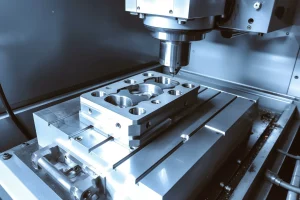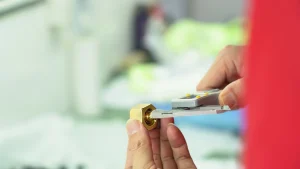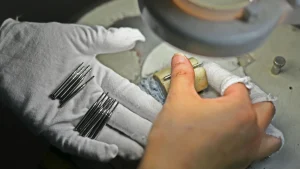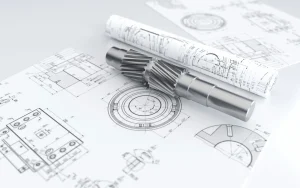Introduction
In the wondrous world of CNC machining, every component is like a meticulously crafted work of art, and the turbine blade component we’ll introduce today is a true classic. Whether it’s precision aerospace systems or high-pressure pumps and valves in industry, it ensures smoother power transmission. Yes, this is our CNC-machined titanium alloy impeller!
1. Material Composition: “Light, Strong, and Durable” Titanium Alloy: Full of Buffs
This impeller is made of TC4 titanium alloy (also known as Ti-6Al-4V), a true “hexagonal warrior of the material world”:
Its high strength allows it to withstand the pressure of steel while being significantly lighter, reducing weight while increasing power.
It also offers exceptional corrosion resistance, remaining unaffected even in acidic and alkaline environments and high temperatures, ensuring an exceptionally long lifespan.
Furthermore, its moderate thermal and electrical conductivity and shock resistance make it a truly “material specifically designed for powertrain components.”
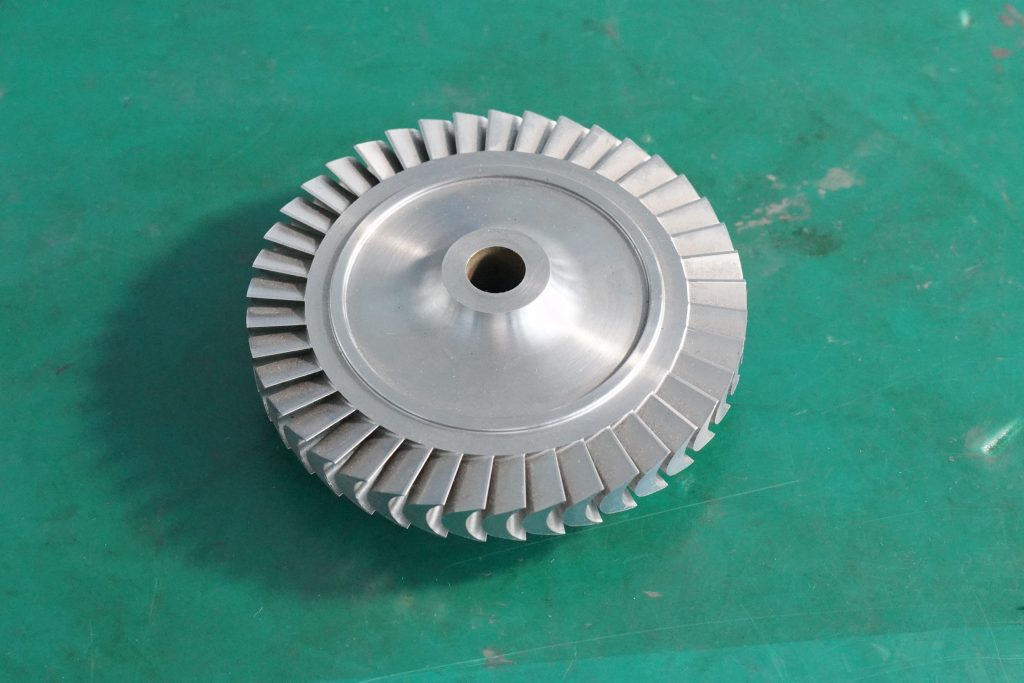
2. CNC Machining “Masterpieces”: Five-Axis Collaboration for “Precision Surgery” on Impellers
Machining this part is like carving a complex work of art, requiring the expertise of a five-axis CNC machine. The machining steps are as follows:
l Blank Clamping: Secure the titanium alloy blank securely to the machine table, like a safety belt for a competitor, to prevent it from wobbling during machining.
l Rough Machining: Use a carbide end mill to remove excess material, initially outlining the general shape of the impeller. This requires careful control of the amount of material removed, as titanium is very hard, and the speed must be controlled.
l Finishing: Carve the Wings: Switch to a finer ball-end milling cutter, and the five-axis system begins “carving” the blades! The machine’s X, Y, and Z axes control up, down, left, right, and forward/backward motion, while the A and B axes (or C axis) allow the table/spindle to rotate flexibly, grinding out the complex curved surface of the blades bit by bit, like “giving the impeller precise little wings.” l
Detailed finishing touches: Machining the center hole and polishing the surface to achieve a mirror-like finish on the impeller, reducing fluid resistance and ensuring a seamless fit in subsequent assembly.
In addition, there are some other processing considerations:
l Use carbide or even diamond-coated cutting tools. Otherwise, titanium alloy is too hard and ordinary cutting tools will easily chip.
l Fine-tune cutting parameters: Avoid high speeds (to prevent tool overheating) and maintain a slow and steady feed rate, like chewing food, to prevent vibration and deformation of the impeller.
Stable clamping: Due to the unique shape of the impeller, uniform clamping force is required, otherwise it will easily wobble during machining.
Add cooling and lubrication: Specialized cutting fluid is required at this stage to cool and lubricate simultaneously. Otherwise, due to the poor thermal conductivity of titanium alloy, heat buildup can easily burn the tool and degrade the surface quality.
3. The Function of the Structure: “Little Wings” + “Hinge Hole”: A “Super Converter” for Power Transmission
Look at this impeller. The outer blades resemble “carefully arranged little wings,” each with its angle and curvature precise to the micron level. As they rotate, they efficiently “stir” the fluid (gas or liquid), converting its energy into power or transferring it to the fluid. The central hole in the center acts as the “power transmission hub,” seamlessly connecting to the shaft for lossless power transmission.
Simply put, it’s the “power converter” within the device: it either converts fluid energy into mechanical power or transfers mechanical power to the fluid, ensuring the entire system is both powerful and stable.

4. Practical Applications: From aviation to industry, it’s used in equipment worldwide.
Case 1: Germany’s PrecisionPump GmbH – “Upgrading the ‘Heart’ of High-Pressure Pumps”
This German company specializes in industrial high-pressure pumps, serving clients including BMW’s paint lines and BASF’s chemical production lines. The impellers we used previously were either cast with poor precision or made of heavy steel, resulting in high pump energy consumption.
Using our CNC-machined titanium alloy impellers was like “opening the door to a new world”:
- The five-axis CNC-machined blades are smooth and precise, creating minimal fluid resistance and boosting pump efficiency by 20%;
- The titanium alloy is light and strong, allowing the pump to operate faster while reducing energy consumption by 15%;
- The corrosion resistance allows the pump to last longer in highly corrosive chemical environments, significantly reducing maintenance costs. PrecisionPump’s high-pressure pumps are now very popular in the high-end European market. The purchasing manager boasts to everyone, “This impeller is like a ‘pacemaker’ for the pump!”
Case 2: AeroTech, a US company, “Drone Power Takeoff”
AeroTech, while developing a long-endurance drone, encountered a problem: a heavy and underpowered power system. Later, after using our titanium alloy impeller and installing it on their small turbine generator:
- It was 40% lighter than the original steel impeller, allowing the drone to carry more fuel or equipment;
- The impeller’s high precision resulted in a more stable turbine speed, and the generator’s power output was stable and sufficient, extending the drone’s flight time by 3 hours!
Now, AeroTech’s drones have become a hot commodity in North American surveying and inspection, and engineers agree that our impellers are simply amazing.
Conclusion
Whether it’s a German high-pressure pump or an American drone, our five-axis CNC-machined titanium alloy impellers are like a “power wizard,” combining “lightness, strength, precision, and stability” to ensure smooth and efficient power transmission.

